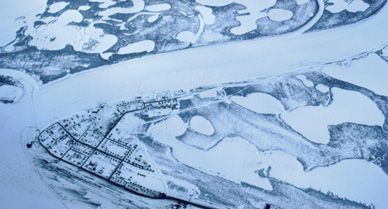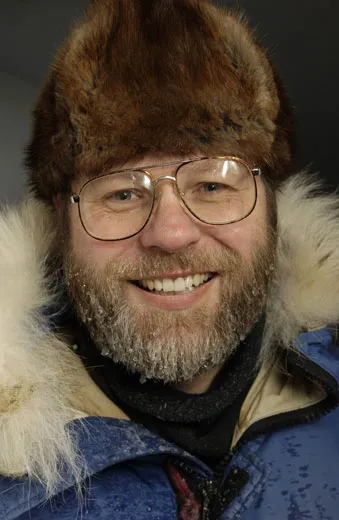Ground Thaw
Geographer Christopher Burn explains why permafrost is thawing
/https://tf-cmsv2-smithsonianmag-media.s3.amazonaws.com/filer/permafrost-ecocenter-388.jpg)
Few of us will ever lay foot on the frozen soil condition known as permafrost, which covers one quarter of the world's landmass, yet it promises to effect us all as climate change sends it into retreat. The rate and magnitude of its thawing is hard to predict - as is its toll on Northern communities and the global carbon budget. One scenario predicts that the massive amounts of carbon frozen within its depths will decompose and enter the atmosphere as it thaws.
Christopher Burn, a geographer at Carleton University in Ottawa, has been keeping a keen eye on soil temperatures throughout Canada's Yukon and western Arctic since 1983. To that end, he ventures to the far North 3-4 times each year to monitor permafrost's demise across some odd 50 sites. His fieldwork provides detailed documentation of the environmental and ecological changes that ensue climate change in northern soils, information he hopes will help northern communities adapt to the changes underfoot.
What's at stake as permafrost thaws?
There are two principal impacts of thawing permafrost. Locally, when ice in the ground melts, the soil loses its strength, and infrastructure built on the surface may settle into the ground, creating, for example, the undulating road surfaces so common in the north.
Globally, a catastrophic consequence of permafrost thawing may be the decomposition and release to the atmosphere of the vast quantities of carbon now stored as frozen peat. Considerations such as this are part of the reason some scientists have warned that we may be close to a climatic "tipping point."
You've been keeping tabs on the ground temperatures in northwest Canada and maintaining a long record of active-layer development in the tundra. What have you found?
The Mackenzie delta area is the most rapidly warming part of northwest North America, or has been over the last 35 years. Air temperatures have risen by over 2.5°C since 1970. In the outer Mackenzie delta it appears that ground temperatures have risen by 1.5 to 2°C over the same period—and the warming extends to over 50 meters in depth.
So what does that mean?
With the warming of ground temperatures, the surface layer of ground above permafrost that is thawed in the summer time thickens. We call this layer the active layer. It's the zone where plants have their roots and take their nutrients.
In the last five years in the western Arctic we've seen a considerable proliferation of the shrub vegetation as the active layer has increased in depth. These bushes trap more snow in the winter, and that in turn keeps the ground warmer. As the ground becomes warmer, the active layer becomes deeper, which means that the bushes can become taller.
There's a positive feedback loop that is leading to the changing of the nature of the surface of the ground. So there is much more subsidence occurring now than I would have anticipated a few years ago, because the deepening of the active layer is leading to melting of near-surface ground ice.
Does this all stem from climate change then?
Nobody will stick their neck out and say with 100 percent certainty it's this or that.
In the mid-70s we began to develop computer models that suggested that as greenhouse gas concentrations in the atmosphere increased there would be consequences for the behavior of the climate. And we're now seeing those predictions reach maturity and become evident.
As an ordinary person, you have to think about whether they got this right by some sort of fluke, or whether we actually have some fundamental understanding that is contained in those scientific models that is being verified or vindicated.
I understand that early records of permafrost from your study areas originate from government and industry data collected in the 60s and 70s. Was climate change on these people's minds then?
In general, when these measurements were made in the western Arctic in the late 60s and early 70s, the purpose was to characterize permafrost conditions, because people were drilling wells to prepare for oil and gas development. So that was the reason rather than an appreciation of climate change and its environmental consequences. I think in the late 60s, in my field, climate change was not on the radar screen, except for considerations related to the ice ages and other global shifts in climate over geologic time.
So on whose radar screen did it first pop up?
One of the grandfathers of the science of climate change was a man called Hubert H. Lamb. He was a British fellow. And I can remember one of the things he did was to read ship's logs from Elizabethan times. He would try to reconstruct the weather and climate around the coast of the British Isles nearly 500 years ago and show that it wasn't the same was what people experience today.
Would you have predicted the change you've witnessed in the Arctic landscape?
The only comment I would make is that I've been surprised, particularly in the last five years, at the rate of change in the landscape.
What have the past 24 years of work taught you to expect from the next 24?
As our great climate change experiment continues, I am sure we will learn much about the behavior of northern ecosystems. Unfortunately, we may wish we had known some things earlier and had been able to prevent certain events that have come to pass.
A great challenge of science is to anticipate the future and suggest a likely range of future conditions, for the earth is too complex to allow definitive prediction over long time scales.

